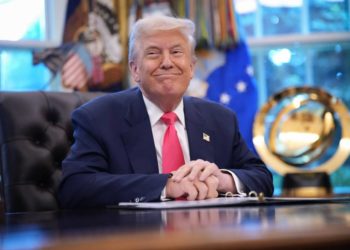At a summit in Alaska last Friday, Russian President Vladimir Putin reportedly told U.S. President Donald Trump that Ukraine must cede control of the country’s eastern Donbas region as a condition for ending the war.
Ukrainian President Volodymyr Zelensky has repeatedly said that he will not make territorial concessions in exchange for a peace agreement, while underscoring that it’s not within his constitutional authority to do so.
Zelensky earlier this month warned that Russia would use the Donbas as a “springboard for a future new offensive” if Ukraine fully handed it over. “If we leave Donbas of our own accord or under pressure, we will start a third war,” Zelensky said. Recent polling also shows that a strong majority of Ukrainians (75 percent) oppose formally ceding land to Russia.
The Donbas, which is short for “Donets Basin,” is an industrial and mining region that borders Russia. It’s made up of two oblasts, or provinces—Donetsk and Luhansk—that are home to roughly 4 million people.
Here’s what you need to know about the Donbas—why it has been a flash point in the Ukraine war from the start, and why it is poised to remain at the center of tensions between Kyiv and Moscow for the foreseeable future.
A symbolic and strategically vital region
One of Putin’s key justifications for invading Ukraine has centered on the Donbas. Putin, a former KGB officer whose nostalgia for the Soviet era is often on full display, has made the case that the war in Ukraine is part of a justified effort to reclaim Russian lands, and he’s frequently portrayed the Donbas as historically Russian.
In 2022, Putin baselessly claimed that Ukraine was committing genocide against Russian speakers in the region. This echoed prior false claims that Putin made against Georgia, which like Ukraine is a former Soviet republic, regarding South Ossetia before Russia invaded the country in 2008.
Ukraine is a former Soviet republic, and much of it was also formerly part of the Russian Empire—and it’s true that Ukrainians and Russians share many cultural, economic, and historical ties. But Putin has distorted history and facts with many of his claims about the country and people, which experts view as part of a broader effort to erase Ukraine’s nationhood and distinct identity.
Putin’s claim about Russian speakers being persecuted in the Donbas is “garbage propaganda” and an attempt by the Russian president to justify his “decades-long obsession” with “dominating” and “eliminating” Ukraine, William Taylor, a former U.S. ambassador to Ukraine, told Foreign Policy.
The Donbas is heavily populated by Russian speakers, a product of the region’s close proximity to and historic links with Russia. The region was an important industrial and mining hub for the Soviet Union, resulting in a major influx of Russian workers during the Soviet era—particularly during a period of reconstruction post-World War II.
Russian is often the first language of people in the Donbas, including ethnic Ukrainians. According to Ukraine’s most recent census, conducted in 2001, ethnic Russians comprised about one-third of the population in the Donbas, while ethnic Ukrainians made up a little over half. When the Soviet Union collapsed, roughly two-thirds of residents of the Donbas considered Russian their first language. Recent polling also found around 51 percent of people in eastern Ukraine speak a mix of both Ukrainian and Russian at home.
Though the Donbas has historic links to Russia and a large Russian-speaking population, people in the region are not necessarily sympathetic to Moscow—despite Putin’s claims to the contrary. Some of the Ukrainian battalions that began fighting against pro-Russia separatists in the Donbas in 2014, such as the Dnipro-1 battalion, were Russian-speaking, for example. The Donbas is a prime example of the convoluted dynamic between language and national identity.
The region’s voting history also paints a complex picture in terms of its sentiments toward Russia. In 1991, for example, Ukraine overwhelmingly voted for independence from the Soviet Union, including 83 percent of the Donbas. But in Ukraine’s 2010 presidential elections, Viktor Yanukovych’s pro-Russia party won by a landslide in the eastern region.
Zelensky, whose first language was Russian and who campaigned on bringing the war in eastern Ukraine to an end, was overwhelmingly backed by voters in non-occupied parts of the Donbas in the country’s 2019 election.
Ukrainians in the Donbas have also expressed resentment toward Russia as the war devastates their region and kills their relatives.
Beyond the Donbas’s symbolic importance to Putin, the region also has significant strategic and economic value. It’s a resource-rich territory with coal and mineral deposits, as well as farmland, and coastline along the Sea of Azov. This helps explain, in part, why the Donbas has been such a focal point in the war.
The heart of the war
Ukrainians often say that the war did not begin with Russia’s full-scale invasion in 2022, but in 2014—a time of immense political and social upheaval for Ukraine. That year, Russia invaded and illegally annexed Crimea from Ukraine and began backing pro-Kremlin militants in a conflict against Ukrainian forces in the Donbas.
Not long after Moscow’s annexation of Crimea, which was condemned worldwide, pro-Russian separatists in the Donbas began seizing territory and declared breakaway republics: the “Donetsk People’s Republic” and “Luhansk People’s Republic.”
Fierce battles were fought between Ukrainian forces and the Kremlin-backed separatists early in the conflict. Cease-fire agreements, known as the Minsk accords, were signed in 2014 and 2015 that helped tamp down the fighting. But the agreements were never fully implemented, and the conflict continued with varying levels of intensity for eight years—ultimately killing around 14,000 people.
The fighting that began in 2014 in the Donbas, which has seen around 1.5 million people flee from the region in the time since, laid the groundwork for Russia’s broader invasion eight years later. With the support of the Russian military, separatists in the Donbas had already seized roughly one-third of the region by the time Putin ordered the start of the “special military operation” in February 2022.
In the lead-up to the invasion, Putin formally recognized the independence of the self-declared separatist republics in the Donbas as well as recognized all of the rebels’ territorial claims in the territory. At the time, then-U.S. President Joe Biden warned that Putin appeared to be “setting up a rationale to take more territory by force.”
When Russia launched its full-scale invasion in 2022, it did so with the goal of subjugating all of Ukraine. Western governments were extremely concerned that Ukrainian forces would be overwhelmed and warned that Kyiv could be conquered in a matter of days.
But the Ukrainian military put up a much stiffer resistance than expected, inflicting significant casualties on Russian forces. Russia failed to seize Kyiv and in its broader war aims more generally. After its early failures, Russia in March 2022 signaled that it was shifting its attention to “the liberation of Donbas,” calling it the “main goal” of the war.
But after over a decade of fighting in the Donbas, first by Kremlin-backed separatists and then by the Russian military itself, Russia still does not fully occupy the region. Russian forces currently control about 88 percent of the Donbas, occupying all but a sliver of Luhansk and roughly 70 percent of Donetsk. Ukraine still controls around 30 percent of Donetsk, and roughly 250,000 people live in those non-occupied parts of the oblast.
Ukraine’s fortress belt
Experts widely agree that Russia doesn’t have the capacity to rapidly conquer the rest of the Donbas and that doing so would cost tens of thousands of lives and likely take years. Putin’s insistence that Kyiv give up the remainder of the Donbas without a fight is considered one of many signs that he does not sincerely desire long-term peace—despite Trump’s relative optimism about the chances for an agreement to end the war (though Trump has also conceded that Putin may not want to make a deal).
Putin is “not genuinely considering a peace agreement other than on terms that has Ukraine capitulating,” Taylor said. The Russian leader launched the full-scale invasion in 2022 as an “all-out attempt to dominate Ukraine” and eliminate it as a sovereign nation, Taylor said. “I am convinced that’s still his goal.”
Russian forces occupy roughly one-fifth of Ukraine, but they continue to struggle to make more than incremental gains on the battlefield. Russia has “not made big progress” in capturing Ukrainian-held territory in the Donbas over the past year or so, Taylor said, pointing to the Russian military’s failed efforts to seize the eastern city of Pokrovsk as a prime example.
Several major cities in western Donetsk that are still held by Ukraine—Kramatorsk, Sloviansk, Kostyantynivka, and Druzhkivka—are also considered to be important parts of Kyiv’s “fortress belt” and crucial to its ability to defend the rest of the country.
“Ukraine has spent the last 11 years pouring time, money, and effort into reinforcing the fortress belt and establishing significant defense industrial and defensive infrastructure in and around these cities,” the Institute for the Study of War, which has closely tracked the conflict in Ukraine for years, said in a recent report.
Along these lines, Taylor said it would be “unthinkable” for Ukraine to “voluntarily” give up the “strategic high ground” in the Donbas and relinquish control of these fortress cities, and it’s “nonsense” for Putin to “demand or even propose” such a scenario.
But while Ukraine doesn’t want to give up the land it still holds in the Donbas, the unfortunate reality for Kyiv is that it’s also extremely unlikely to regain control of Russian-occupied territory in Donetsk or Luhansk.
As things currently stand, and with Trump continuing to push for a deal to end the war, this could mean that Ukraine may have to offer de facto recognition of Russia’s control of territory in the Donbas—and other parts of the country—to get an agreement across the finish line.
But even if that happens, it could only be a matter of time before Putin restarts the war. Meanwhile, Russia is still aggressively pushing for more territory in Ukraine. This is why there are growing calls among Ukraine’s supporters for Trump to strengthen Kyiv’s negotiating position by significantly ramping up pressure on Moscow with increased military support for Ukraine and harsh economic penalties for Russia.
The “best-case scenario” moving forward is that Trump uses the economic, military, and political leverage he’s got to “convince Putin that he can’t win,” Taylor said. Putin is “just going to stall and pound the Ukrainians until and unless Trump uses the leverage he’s got,” he warned.
The post Why the Donbas Matters to Putin So Much appeared first on Foreign Policy.




